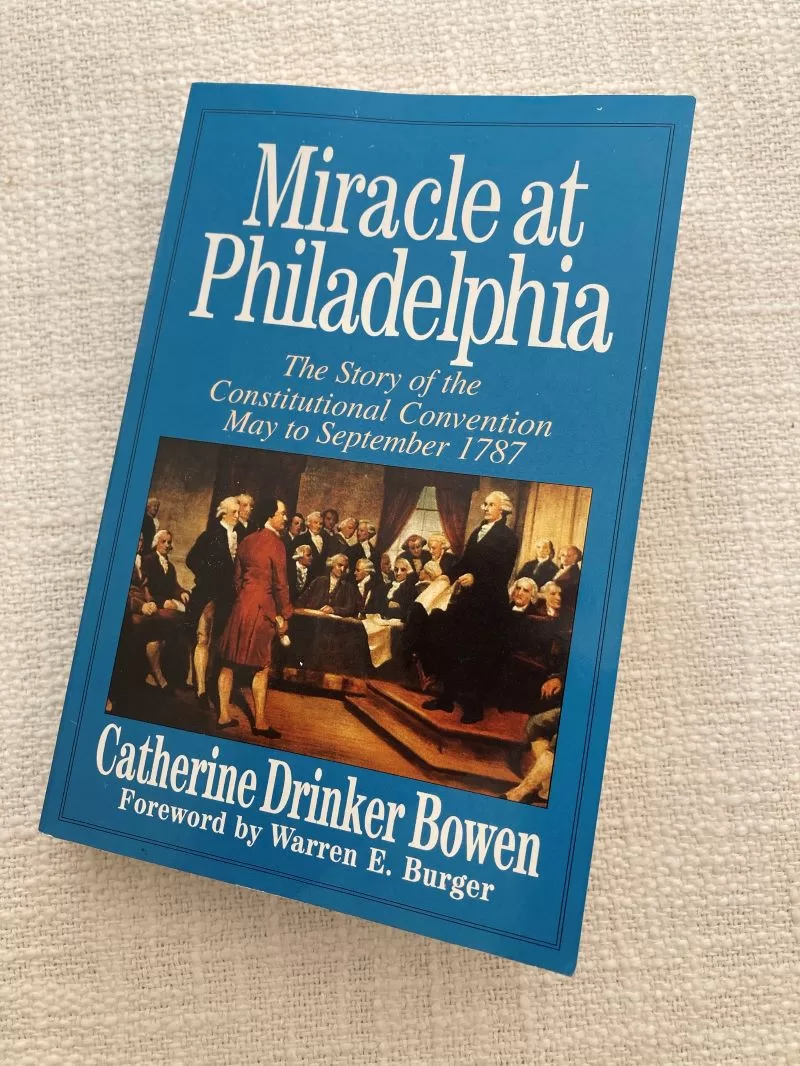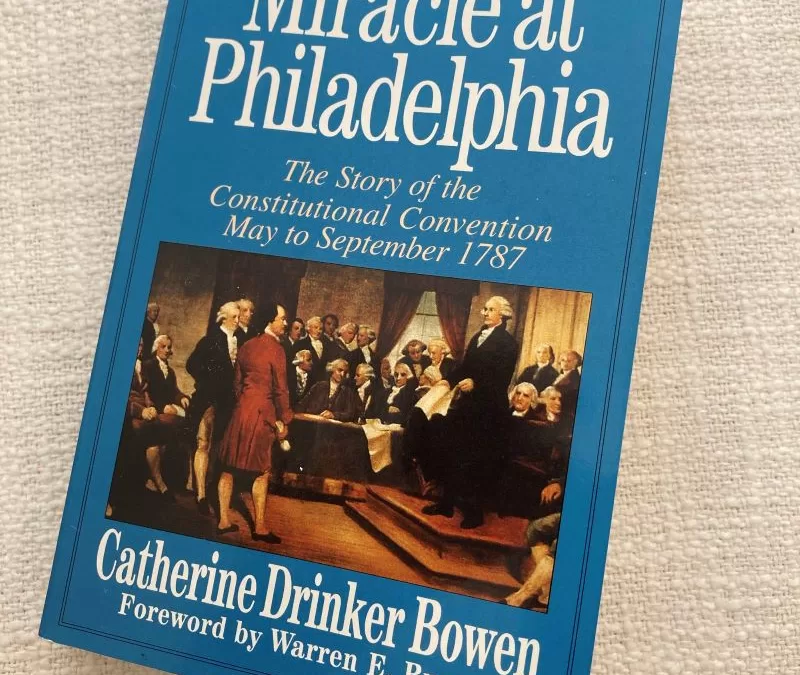
In Civics 101, where students learn about the structure and function of the United States Constitution, we are typically taught to revere the document that established our nation’s plan of government and to speak of those who “framed” it in the highest regard. There is substantial evidence to warrant the praise, particularly the generally held view that the USA under the Constitution they wrote established the “longest standing democracy in the world” and that, over time, basic civil rights such as voting have been extended to previously excluded groups.*
With that said, a certain mythology has evolved that tends to elevate the Constitution to an exalted status unsupported by history and the facts. And, as is so common today, many of these myths have been deployed for political advantage; none so comprehensively sweeping as the notion of “constitutional originalism.”
I think of all this now after reading Miracle at Philadelphia: The Story of the Constitutional Convention May to September 1787 by Catherine Drinker Bowen, a classic account of how our plan of government was created.
Modern originalists—for there are no other originalists—believe that we should interpret the Constitution and the laws that have come about within its provenance in terms, not only of what was written and then ratified, but what they intended when they wrote it based upon what they were thinking at the time. “They” of course, are the Framers—capitalized out of respect—who in 1787 gathered in Philadelphia to revise the nation’s first constitution, the Articles of Confederation; because it was widely believed that the country would not survive under that loose alliance of 13 largely independent states. So, what they were thinking at the time—and what they intended—can be largely deduced from the four months during a scorching Philadelphia summer where the governing issues of the day, and subsequently our present Constitution, were hammered out.
In all, 70 men were appointed by 12 of the 13 states, some of whom could not attend. Rhode Island and other appointees refused to attend because they opposed the establishment of a stronger central government. Others objected to the legitimacy of the convention itself. Indeed, the mandate that created the convention in the first place did so for “the sole and express purpose of revising the Articles of Confederation.” A total of 55 delegates attended at some point, although a few only briefly and, in the end, 39 were willing to sign what had been agreed to.**
Many of these men were in their twenties and thirties while the oldest was 81-year-old Benjamin Franklin. who was so frail as to require the services of a sedan chair carried by four prisoners from the nearby Walnut Street jail. George Washington was unanimously elected president of the convention.
So, when originalists argue that interpreting the Constitution—in its un-amended form, anyway—it is the thinking and intent of these men upon which they rely.
On the down side of sussing this one out is that the proceedings from May to September of 1787 were held with the utmost secrecy so that delegates to the Federal Convention could speak their minds and the newspapers wouldn’t stir up trouble before they were done with their work. On the plus side was the presence of a delegate from Virginia, James Madison, who later wrote, “…I was not absent a single day, nor more than a casual fraction of an hour in any day, so that I could not have lost a single speech, unless a very short one.” He also took copious notes.
Bowen quotes a letter from Thomas Jefferson to John Adams in 1815: “Do you know that there exists in manuscript the ablest work of this kind ever yet executed, of the debates of the constitutional convention of Philadelphia…? The whole of everything said and done there was taken down by Mr. Madison, with a labor and exactness beyond comprehension.”
Catherine Drinker Bowen draws heavily from these documents that are the gold standard of good history writing—primary sources—including Madison’s notes and letters like this one sent to and from the delegates both during and after the convention.
After only a few short chapters of Miracle at Philadelphia it becomes clear that, while the Framers agreed on a few general principles of good government, such as the need for a separation of powers and a system of checks and balances to prevent abuse, the actual details that made their way into the Constitution regarding the best way to accomplish this were agreed upon only after tumultuous debate over dozens of issues.
A matter of grave importance was determining how the states should be represented in the new federal government. Remember that each of the thirteen colonies had been founded under different circumstances and settled by various groups giving each of the states a unique character with a unique set of interests. Small states feared being swallowed whole by the likes of Virginia with nearly 20% of the nation’s population; more than the population of Vermont, New Hampshire, New Jersey, Delaware, and Georgia combined. Northern and Southern states had vastly distinct economic interests.***
There were concerns over the manner in which new states would enter the Union. At the very moment of the convention, settlers were flocking beyond the Appalachians after the treaty with Great Britain had placed the western boundary of the new country at the Mississippi River. Would these new states come to dominate the Union and what kind of people are they anyway? Also, many of the delegates owned land in the West and securing a stronger central government would almost certainly pad their pocketbooks.
And what of the power to levy taxes? Raise an army and navy? What powers would the president have? What role would the federal judiciary play? What explicit limitations would be put upon the government in regards to the rights of the people, meaning should a bill of rights be included or not?
Who should elect the members of Congress, the people or state legislatures? Who should have the right to vote in a time when, as Bowen writes, “the word democracy carried another meaning than it does today. Democracy signified anarchy; demos was not the people but the mob”? And what of slavery?
There were as many answers to these questions—and many others—as there were delegates. Despite these well-documented origins of our Constitution, originalists would have us believe, in their near-holy reverence for the “intent” of these men, that there was, at the time, only a single right and moral answer to the plethora of questions that were eventually answered in the Constitution.
The harsh reality is that the country faced threats from a multitude of domestic and foreign sources. US currency was virtually worthless because there was no national power to tax. Disputes between states went unsettled. On the country’s western boundary, Spain was poised to take control of the Mississippi River. There were rumors that a group of New Yorkers were negotiating an alliance with Canada. There was no national defense, only the individual militias of each of the states.
These problems and more, with the looming threat of disunion, were the guiding influences of the delegates in Philadelphia. Their only “intent” was to solve these problems by creating a more powerful central government for a nation of three-and-a-half million people; one percent of today’s population… in a world where messages traveled at the speed of a horse or a wooden sailing ship, doctors used bloodletting to treat a variety of ailments, the average life expectancy for a white male was 38 years, and roughly one million human beings were enslaved.
The greatness of our Constitution rests not with the compromises that were made in 1787 but with the principles that guided the Framers to solve the problems of the day: a separation of powers along with a system of checks and balances, popular sovereignty, limited government, a federal system defining the relationship between the central government and the states, representative government, and the protection of individual rights.
In short, our beloved Constitution is a collection of compromises made by a few dozen men with competing and conflicting degrees of self-interest, while sharing, for the most part, only that they hoped to hold the country together.
In an example of the value of primary sources, Bowen cites a speech written by Benjamin Franklin—but read by fellow Pennsylvania delegate James Wilson—encouraging reluctant delegates to put their name to the document: “I confess that there are several parts of this constitution which I do not at present approve,” Franklin admits. “But I am not sure I shall never approve them… For having lived long, I have experienced many instances of being obliged by better information or fuller consideration, to change opinions even on important subjects, which I once thought right, but found to be otherwise. It is therefore that the older I grow, the more apt I am to doubt my own judgment, and to pay more respect to the judgment of others.” (If only we lived among such people today…) He continues, “Sir, I cannot help expressing a wish that every member of the Convention, who may still have objections to it, would with me, on this occasion doubt a little of his own infallibility—and to make manifest our unanimity, put his name to the instrument.”
Finally, a precedent was set in 1787 that puts the lie to originalism. For, if the original work of those who established America’s first constitution had had their way, there would have been no Constitutional Convention, no Constitution, and inevitably, no country. What the Framers demonstrated for us, then, is that when we have a constitution that doesn’t work, we call upon the best among us to fix it. And, if it is determined that the system as it exists is beyond repair, we replace it.
I find it much more satisfying to honor the Framers’ example in this regard rather than proclaiming that the messy work they did is sacred and unimpeachable. Thanks to Catherine Drinker Bowen for the clarity she brings to the matter.
*https://www.weforum.org/agenda/2019/08/countries-are-the-worlds-oldest-democracies/
**https://www.archives.gov/founding-docs/founding-fathers
***https://en.wikipedia.org/wiki/1790_United_States_census#Loss_and_availability_of_data












